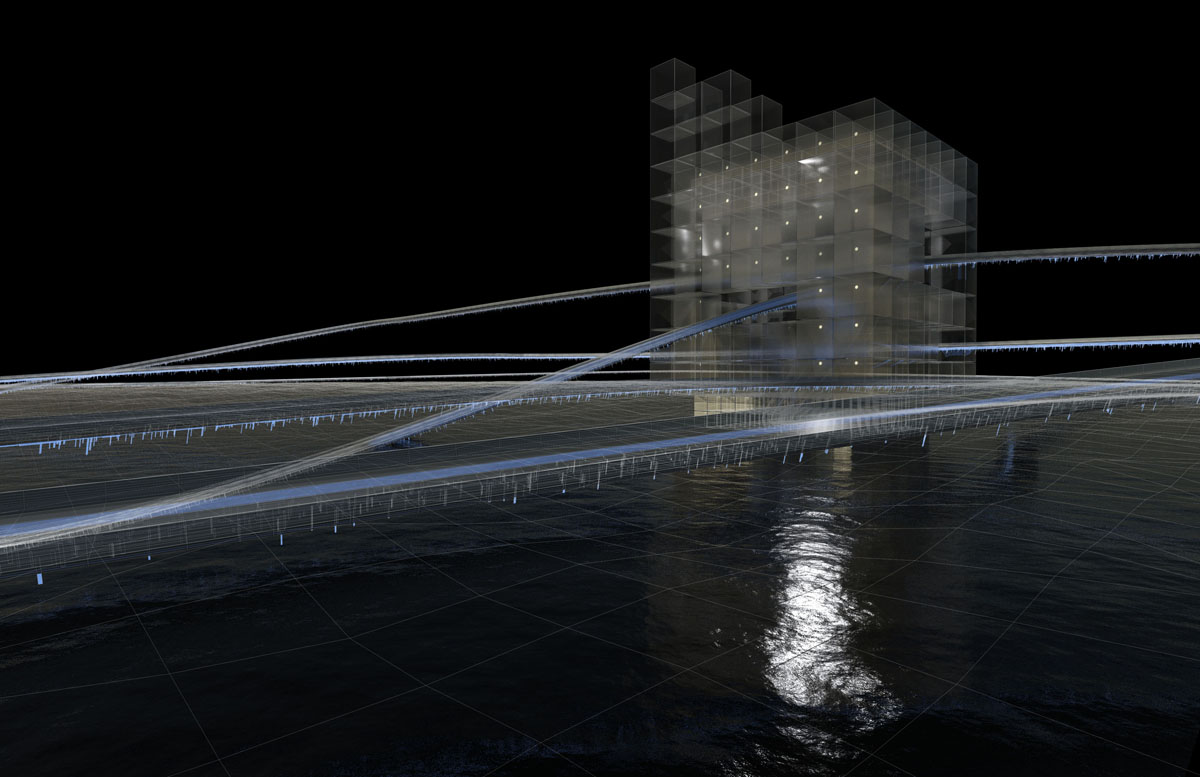Reactscape device:space
Cyborg : Prosthetic
Bradley Cantrell, Jeff Carney, Kristi Dykema
The single mindedness of infrastructure limits its abilities to be truly reactive to needs outside its narrowly defined job. As our industrial infrastructure grows to control and limit more and more of the natural systems of our globe, it must grow more complex and intelligent.
Infrastructure, as we know it is parasitic. It is an external organizing framework, a prosthetic, gaining power and legitimacy when situated at the confluence of latent elements and their potential for flux. Infrastructure simplifies and controls systemic natural forces (ether, terra, and water) in order to maximize the potential energy that each possesses. The flow of a river, heat from the earth’s crust, or a gust of wind can be harnessed and trained for consistency, repetition, and predictability.
Three elemental systems converge to form our planetary environment; water, terra, and ether. This convergence expresses a complex range of subsystems where water, terra, and ether mix to create mutable, evolving relationships. Each unique relationship yields a temporal state that yearns for equilibrium but is in a consistent state of emergence. The exocentric, static explanation of the subsystems labels features as wetlands, rivers, and/or deltas but in reality each is a layered relationship where adjustments can create lakes from wetlands or vice versa. Infrastructure must then operate within this elemental framework cognizant of adjustments that alter a range of subsystems.
This study begins as a trip up the Mississippi river. The first major piece of American infrastructure, it is a case study in the stasis and flux of a natural system and man’s attempts to harness its power. The resultant river landscape is a cyborg; a system that functions with the benefits of both the natural and manmade but without clear distinctions between them.
Control Prosthetic
The prosthetic is the static interface between technology and ecology vwhich is the current state of infrastructure. The implementation of the prosthetic is singular, fulfilling a specific need but ignoring contextual complexities. The prostethic interfaces biologies minimally, reducing complexity within systems that are infinitely complex. When deployed at regional scales the landscape is shackled, unable to respond to shifts in systems and sub-systems.
Latent Strata
Layered, filtered, mixed and blurred in ways that maintain a latent state, preserving potentials for their eventual exploitation and alteration. The static state of air, water, and earth represent a potential or capacity for later exploitation. The resting state of the elements of air and earth are arranged in infinite ways reflecting their long course of slow change with time.
Pressure/Flux
These forces cause the constant reorganization of the strata – ruptures, transformations, evolutions. The resultant force emerges based on specific arrangements of strata and the energy differentials between them. These forces indicate the productive capacity of now-non-latent systems to constantly, occasionally, or gradually change the composition of materials in the system within a given range or tolerance.
Mechanism:Prosthetic:Cyborg
The deliberate operation of transforming strata. Mechanism that sets enacts tactical operations in the environment in order to incite and/or simpy control the transition between latent energy and flux. The mechanism is less of an object than an operation. Its objective form can be quite mutable as it becomes part of larger systems of infrastructure. It is the “go-between” for the programmatic responsibilities of infrastructure and the power of the latent potentials of the strata.
Here we posit five visions of a new infrastructure. It must engage fully as more-than-prosthetic to the cyborg landscape. It can rise above the single-mindedness of its programmatic charge and engage as a reactive and flexible strand in the most intricate network: our planet.





